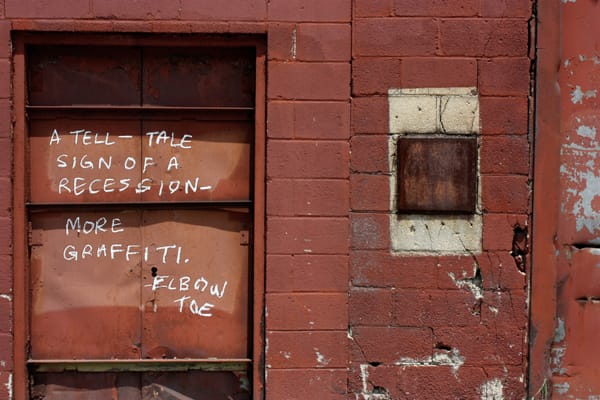New York's Obsessive Graffiti Disorder
BEWARE! If you just got laid off you may be at high risk for OGD: Obsessive Graffiti Disorder. According to a recent New York Times article graffiti is sprouting up like bad acne in cities all over the country and the recession is partly to blame. The article narrowly treats graffiti as a pathologic

BEWARE! If you just got laid off you may be at high risk for OGD: Obsessive Graffiti Disorder. According to a recent New York Times article graffiti is sprouting up like bad acne in cities all over the country and the recession is partly to blame. The article narrowly treats graffiti as a pathological pastime of a depressed nation, or a symptom of social turmoil at large. Yet after reading this biased report filled with mostly disgruntled quotes from city officials, I wonder what else the Times could have addressed in order to offer a bigger picture on graffiti and street art rather than the usual concerns it brings of urban apocalypse.
The article argues that economic decline and unemployment has led to angry youth who feel the need to lash out on the streets of their city, an analogy that appears reasonable on the surface. Suffering neighborhoods are commonly more tagged up than others, but this could mainly be the result of limited budgets to cover up the graffiti rather than just the manifestation of general malaise and unhappiness in the area. The Times also fails to make a key distinction between tagging, which may serve no other purpose than to mark one’s presence, and street or graffiti art that has sophisticated imagery and an engaging message behind it. By lumping the two together, the article obliterates the chance to have a more analytical and honest discussion about what street and graffiti art truly has to convey.
While the Times only considers economic deprivation as a catalyst for street art and graffiti, the recent explosion of street art after uprisings in the Middle East tells a different story. Egyptian artists like Ganzeer, whose Martyr Murals project honors casualties from the protests, are now using the streets as an arena to enact new freedoms of expression. Ganzeer notes on his blog that his work is intended to “provide passers-by with a reminder of Egypt’s struggle for freedom, democracy, and equality;” a struggle that is far from over. Although many of Ganzeer’s murals have been painted over by government officials, his type of street art provides another platform for citizens of Egypt and across the Middle East to fight for democratic values. These works are not simply caused by social and economic strife; they are also a reaction to these issues that belong in the streets where they will gain the most visibility. While the Times article condones the streets as the site of festering wounds, it ignores the fact that some street art can be both a barometer for changes happening in the surrounding society as well as a the spark for change itself.
Even street pieces that err on the side of tagging and have less artistic imagery than Ganzeer’s can awaken us from our apathy. A few months ago Death + Taxes Magazine reported on a red spray painted slogan on Fourth Avenue and 13th Street that reads, “Why do we just accept things?” The question speaks directly to graffiti’s ability to reveal aspects of the world that we often chose to ignore or deny.
Much of the scare around graffiti, as the Times article attests to, is the assumption that it will breed further urban decay. This notion dates back to the Broken Windows Theory developed by social scientists in the 1980s who claimed that any small sign of disorder in a neighborhood, including graffiti or trash, would influence more crimes and dangerous behavior. While its true that graffiti can give a neighborhood a bad rap, there is also a need for a new vocabulary for graffiti and street art that sees it not just as socially decrepit but also as socially engaged. After all, if graffiti and street art is truly sparked by economic decline, then the focus should be on eradicating the causes of these societal ills and not just the specks of paint that raise awareness about them.




